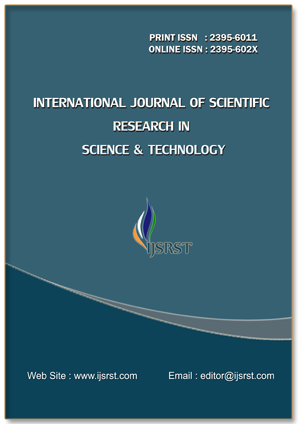Study of Band Gap Reduction and Enhanced light Absorption in DSSC’s using N-TiO2 and Azo Dye Composites
DOI:
https://doi.org/10.32628/IJSRST24115102Keywords:
Dye Sensitised Solar Cell, Azo Dyes, TiO2 Nano-particles, 8% N-TiO2, Energy band gapAbstract
This research delves into enhancing Dye-Sensitized Solar Cells (DSSCs) using Nitrogen added Titanium Dioxide (N-TiO2) nanoparticles. Nitrogen is employed to reduce TiO2's band gap, thereby enhancing its light absorption capabilities. Azo dyes namely VC, RP and RM are chosen as sensitizers due to their efficient light absorption properties. UV-spectrophotometer analysis reveals superior absorption and a lower band gap in N-added TiO2 compared to pure TiO2. Additionally composites of pure TiO2, N-added TiO2 with azo dyes taken in various proportion are explored. Energy band gap of each is calculated using UV- spectrophotometer analysis. Composites made using 8% N and TiO2 with azo dyes VC and RP taken in equal ratio showed the maximum absorption for a range of frequencies from 300nm to 900nm and thus leading to the minimum energy band gap.
Downloads
References
Ikpesu J. E., Sunny E. Iyuke., M.O. Daramola., Akindele Oyetunde Okewale. (2020). Synthesis of improved dye-sensitized solar cell for renewable energy power generation. Sol. Energy, 206, 918. DOI: https://doi.org/10.1016/j.solener.2020.05.002
Wang Z., Tang Z., Wang H., Wang H. (2019). Research progress on nitrogen-doped TiO2 nanoparticles and their applications. Mater., 12, 1817.
Parisi M. L., Maranghi S., Basosi R. (2014). The evolution of the dye sensitized solar cells from Grätzel prototype to up-scaled solar applications: A life cycle assessment approach. Renew. Sustain. Energy Rev., 39, 124. DOI: https://doi.org/10.1016/j.rser.2014.07.079
Grätzel M. (2003). Dye-sensitized solar cells. J. Photochem. Photobiol. C: Photochem. Rev., 4, 145. DOI: https://doi.org/10.1016/S1389-5567(03)00026-1
Zhang W., Haili He., Haoze Li., Linlin Duan. (2021). Visible‐light responsive TiO2‐based materials for efficient solar energy utilization. Adv. Energy Mater., 11, 2003303. DOI: https://doi.org/10.1002/aenm.202003303
Li Z., Lin J. (2015). Nitrogen-doped TiO2 nanotube arrays with enhanced photocatalytic activity under various light sources. Appl. Catal. B: Environ., 162, 123.
Yang X., Wolcott A., Wang G., Sobo A., Fitzmorris R. C., Qian F., et al. (2009). Nitrogen-doped ZnO nanowire arrays for photoelectrochemical water splitting. Nano Lett., 9, 2331. DOI: https://doi.org/10.1021/nl900772q
O'Regan B., Grätzel M. (1991). A low-cost, high-efficiency solar cell based on dye-sensitized colloidal TiO2 films. Nature, 353, 737. DOI: https://doi.org/10.1038/353737a0
Chen C., Yeh M., Teng H., Chen J. (2009). Effect of nitrogen doping on the photocatalytic activity of TiO2 for the degradation of nitrobenzene. Appl. Catal. B: Environ., 90, 440. DOI: https://doi.org/10.1016/j.apcatb.2009.03.032
Yadav S., Patel R., Dhulia V. (2022). Variation of energy band gap in composites of N-doped titanium dioxide for preparation of dye-sensitized solar cell. Int. J. Sci. Res. Sci. Technol., 9, Page range.
Parajuli D., Sandip Dangi., Bhumi Raj Sharma., Nunu Lal Sahu. (2023). Sol-gel synthesis, characterization of ZnO thin films on different substrates, and bandgap calculation by the Tauc plot method. BIBECHANA, 20, 113. DOI: https://doi.org/10.3126/bibechana.v20i2.54115
Benkhaya, S., M'rabet, S., & El Harfi, A. (2020). A review on classifications, recent synthesis, and applications of Azo dyes. Heliyon, 6(1), e03271. DOI: https://doi.org/10.1016/j.heliyon.2020.e03271
Al-Rubaie L. A. A. R., Mhessn R. J. (2012). Synthesis and characterization of azo dye para red and new derivatives. J. Chem., 9, 465. DOI: https://doi.org/10.1155/2012/206076
Downloads
Published
Issue
Section
License
Copyright (c) 2024 International Journal of Scientific Research in Science and Technology

This work is licensed under a Creative Commons Attribution 4.0 International License.
https://creativecommons.org/licenses/by/4.0





